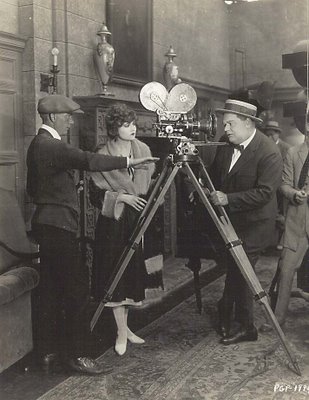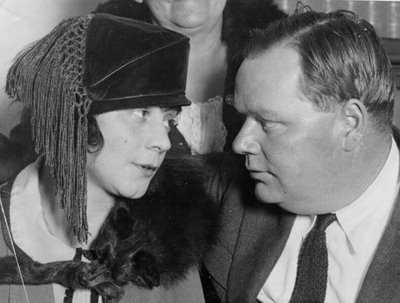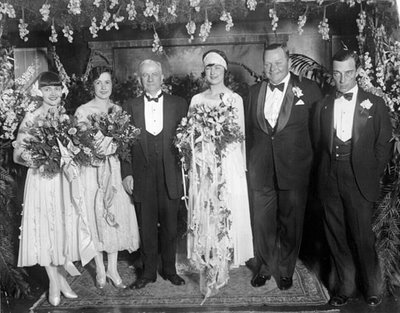
 Roscoe Arbuckle's Birthday
Roscoe Arbuckle's Birthday Nobody got a rawer deal than Roscoe Arbuckle (3/24), but that’s not news. He’s one silent star you can mention among civilians (you know, those non-film fanatics we have to share the planet with), and a surprising number of them know all about him. Or they think they do. Usually, you get Oh yeah, he killed the girl during that orgy, or an indelicate reference to Coke bottles. Well, we know better. So did that third jury when they came out and said the State Of California owed Roscoe a very big apology. Well, how do you give a man his life back after dragging him through a mess like this? They started out accusing him of capital murder, for Cripe’s sake! Some say Arbuckle’s films were allowed to deteriorate over the years because nobody wanted to be reminded of him. They pretty nearly accomplished that, because a lot of them are gone now. Roscoe himself had a vault hidden somewhere, but nobody’s been able to locate it. I wish they could. His reputation could still use some major rehab. As a comedian he’s not up there with Chaplin or Keaton, but maybe we’d all appreciate him a little more if the prints looked better. Whenever I read about that fateful Labor Day weekend in 1921, I think about how close Roscoe came to staying home, then I think if only he had, and all that other stuff we can’t do anything about now. His accusers were a scruffy lot. Blackmailers, abortionist doctors, crooked prosecutors, you name it. Poor Roscoe (notice I don’t call him Fatty --- he never liked that) dropped $700,000 in legal fees (this is 1921 money!) and still got banished from the screen despite his courtroom vindication. The dead woman, Virginia Rappe, was said to have had five abortions by the time she was sixteen, and an out-of-wedlock child when she was seventeen. Wacky Mack Sennett had her tossed off the Keystone lot for spreading venereal disease, though it was later revealed she had lice! Boy, the stuff that went on in those tumultuous teens --- lice --- ugh. So you can see what Roscoe was up against. It’s nice to know he had a comeback of sorts just before the end. Warner Bros. hired him for a series of Vitaphone shorts in 1932. He did six. I’ve seen most of them, and they’re good. A couple of them, Hey, Pop! and Buzzin’ Around, are really good. This was the best exposure Roscoe had since the trial. Warners was talking up more for him, maybe even features. All that collapsed when he died unexpectedly of a heart attack in his hotel room in 1933. He was only forty-six. Good friend Buster Keaton said he died of a broken heart. I don’t know as I agree, although the damage had been done and it was devastating. Still, things were looking up for Roscoe. On that final evening out, he and his wife had dinner with Ed Sullivan, of all people. Is it any wonder Ed was so blasé about The Beatles thirty years later? After all, he’d once dined with the Arbuckles!





Stars who are good to their doggies always rate special mention at the Greenbriar, as I'm devoted to my pooch as well (even if he was sprayed by a skunk last night). This portrait is actually dated 1924, well after Roscoe’s retreat behind the cameras. He might have been seeking a director spot around this time, or perhaps a return to the stage. In any case, that sobered expression reveals a changed man. From happier days, here is Roscoe at Paramount doing close inspection on the camera lens for This Is So Sudden, a title which must have been changed (or the picture abandoned?). We do know his Paramount features were shelved and/or withdrawn after the trial. I assume that’s director George Melford serenading Roscoe and crew during The Round-Up in 1920, but by all means, correct me if I'm wrong. From the trial --- two dramatic shots. Roscoe in the courtroom --- and his stunned, disbelieving countenance tells the whole story, as if the horror of this ordeal were still not fully absorbed. Former wife Minta Durfee provides a courtroom lifeline in a revealing close look at the two --- she was there throughout to provide moral support. Roscoe seems to be regarding the last friend he has left in the world. Maybe he was. Finally, his wedding three years later to Doris Deane on May 17, 1925. The best man is stalwart pal Buster Keaton, and that’s Natalie second from the left. Buster kept a framed portrait of Roscoe on his wall till the day he died.
10 Comments:
I have no doubt that Arbuckle was railroaded. But I don't understand why his defenders always bring up Virginia Rappe's sexual past. It always seems like the underlying message is, "Well, she had what was coming to her!" Slut or no, she was a human being and didn't deserve to wind up the way she did.
Wow... what a change-up, from Natalie Wood to Roscoe Arbuckle.
You pro'lly know that Milestone released a remarkable DVD boxed set of lovingly restored ("rescued" would be a more accurate term) Arbuckle films. I don't find the big guy very funny, but it's nice to see a sample of his work.
Hey, I dunno if you take requests, but your Monday morning girlie pics could use a good strong dose of Jean Rogers. And more Paulette Goddard is always nice.
In reply to anonymous: I don't think historians bring up Ms. Rappe's past for the purpose that you suggest. It's to demonstrate that the root cause of her untimely death ties in with her history of abortions (in the late teens, a "back alley abortion" was just that) and venereal disease. It's a medical judgement, not a moral one.
Whatever her lifestyle, what happened to Virginia Rappe was tragic. But it was equally tragic that so much medical evidence was suppressed by the S.F. D.A. just so he could score a political victory against Hollywood. And it was equally tragic that an innocent man was barred from doing what he did best for over a decade.
Actually, the best package of Arbuckle stuff isn't from Milestone but from a company called Laughsmith. (Milestone has only released some of the Arbuckle-Keaton shorts on a compilation with other things.) Tragically, what I think it shows is that Arbuckle was on the verge of his best work when his career ended. Like Chaplin, he instinctively tried to find a calmer, more character-driven place in the middle of the usual Sennett frenzy. It took him a lot longer to get there than it did Chaplin, but you can definitely see in his best work that he's moving there and would have likely joined the likes of Keaton, Stan Laurel, etc. in creating less frenetic, more unified comedies as the 20s progressed. In any case, to get a sense of what he might have been capable of, see a short on that set called Love, from 1919, which is a remarkable chamber piece, quite imaginative and dramatic, not the usual knockabout stuff. It's a great set and well worth owning.
I agree with some of what anonymous said, but as Michael J Hayde states there is the very real possibility that Virginia's death was due to her lifestyle rather than anything anyone did at the party. All I can say is thankfully Natalie Keaton wanted to go sailing on the Keaton's yacht that weekend otherwise it could have been two great careers ruined. All we can do is spread the word that Roscoe was innocent and found innocent and that his name was Roscoe Arbuckle.
Even harder to find than Arbuckles films are his posters. Most poster exchanges simply threw them away as they felt there would no longer be any need to keep them in stock. ANY original Arbuckle poster is very rare. I once saw a three-sheet from "The Roundup" that had been torn up in pieces and used to wrap projector parts!
LAUGHSMITH. *slaps forehead* Sorry! I knew that! It's LAUGHSMITH!
Michael's right, the Laughsmith Arbuckle box is fabulous. I'm told they're working on a silent Our Gang set at present. That should be great...
Back when TNT was showing old movies, I caught a bunch of Arbuckle's Vitaphone shorts. What impressed me most was how a guy his size could take such a great pratfall. One of the shorts -- can't remember the name -- took place, I believe in a nut house. It struck me as proto-Monty Python. Very funny but, even better, very strange.
The best book on Arbuckle and the trial is "Room 1219."
It points out that, while there are myths that unfairly blacken Arbuckle's reputation (e.g., the Coke bottle), there are likewise myths put out by the Arbuckle side that unfairly blacken Rappe's reputation (e.g., that she had multiple abortions and that Sennett had to fumigate his studio).
Incidentally, the author concludes that Arbuckle inadvertently caused Rappe's death during consensual sex (which is not a crime). I don't necessarily agree, but the great thing about the book is that it puts all the evidence out there so you can form your own opinion. He also concludes that she might not have died but for medical malpractice in treating (or failing to treat) her ruptured bladder.
Post a Comment
<< Home